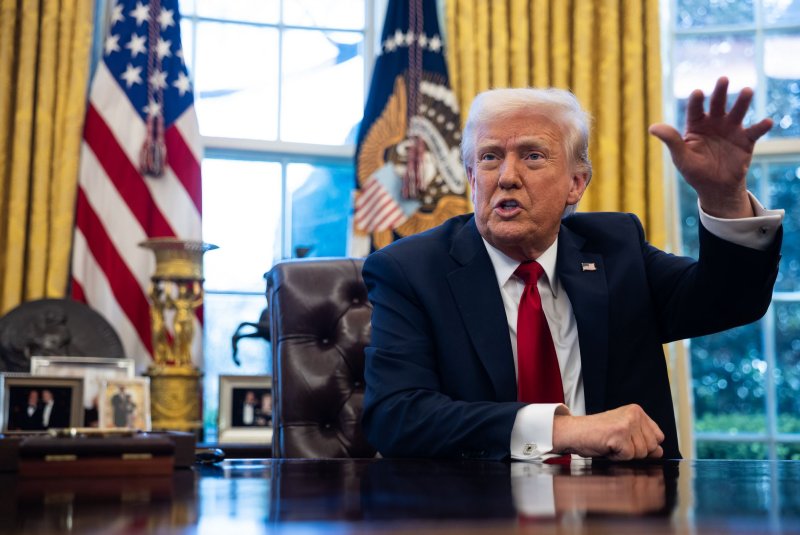March 26 (UPI) — President Donald Trump on Wednesday signed a 25% tariff on new autos and light trucks built outside the United States that will go into effect Tuesday in an effort to spur domestic manufacturing
No duties will be placed on car parts made elsewhere, and Trump said he expects the entire vehicle ultimately to be made in the United States.
His executive order will apply to “foreign-made cars and light trucks,” including vehicles made in Mexico, Canada, Japan, South Korea, China and Europe.
These tariffs are on top of any existing ones already in effect.
The order will “spur domestic protection,” resulting in $100 billion of new revenue, supporters said. Trump said the tariffs are “going to make our country rich.”
“This is very exciting,” Trump said about the order that “that’s going to lead to tremendous growth in the automotive industry.”
As part of the order, he allowed an interest tax deduction for American-made cars.
“When you get a loan to buy a car, and think it will pay for itself, you will only get that deduction if the car is made in the United States of America,” he said at the signing in the Oval Office.
European Union officials earlier announced plans to allow tariffs during Trump’s first term to return, and have said they will place a new set of tariffs on a wide variety of American goods — from lingerie to soy products — by mid-April. Trump also plans to announce more tariffs on Tuesday.
The Canadian Chamber of Commerce said, according to The New York Times: “Throwing away tens of thousands of jobs on both sides of the border will mean giving up North America’s auto leadership role, instead encouraging companies to build and hire anywhere else but here. This tax hike puts plants and workers at risk for generations, if not forever.”
The United States is the largest market for the Japanese automakers, including Toyota, Honda, Nissan, Mazda and Subaru.
Most Japanese vehicles sold to buyers in the United States are made in their nation. Of the 2.3 million cars Toyota sold last year in the United States, about one million were made outside the country.
Before the announcement, the Wall Street Journal said they would be on “finished vehicles” and not on auto parts.
Shares in the U.S.’ largest automakers initially fell before the announcement but rallied after the Wall Street Journal reported details of auto tariffs.
Before Trump’s announcement, Ford rose 0.01 to 10.30, General Motors dropped 1.64 to 50.95 and Stellantis declined 0.44 to 11.96. Tesla declines 16.08 to 272.06, but ahead of its five-month low of 222.15 on March 10.
Trump said he hasn’t spoken with Tesla CEO Elon Musk, who runs the Department of Government Efficiency about the tariffs. Tesla’s cars are made in the United States as well as outside the United States.
At the 4 p.m. close, stock prices broadly were lower. The Dow Jones Industrials were down 132.71, or 0.31%, to 42,454.79, Standard & Poors 500 declined 64.45, or 1.12%, to 5,712.2 and tech-heavy Nasdaq Composite slid 372.84, or 1.2%, to 17,899.01.
Car prices predicted to rise
The cost of producing vehicles built at US plants will rise by several thousand dollars, according to analysis by Michigan-based think tank Anderson Economic Group.
“It’s almost $9,000 per car for a full-size SUV with substantial Mexican content,” CEO Patrick Anderson said last month on an Automotive Press Association webcast. “If you don’t make production adjustments or shut down lines, it could be above $10,000.”
Mexico is the largest source of U.S. auto imports, accounting for approximately 14% of all cars bought in the United States. Japan is second followed by South Korea, the European Union and Canada.
A total of 4 million vehicles were built in Mexico in 2024, according to data from S&P Global Mobility, with 2.5 million, or 61%, were shipped to the United States.
In Canada, 1.3 million vehicles last year, of which 1.1 million, or 86%, were exported to US dealerships.
Conversely, the United States exported $35.8 billion in parts to Mexico last year, according to federal trade data, and another $28.4 billion to Canada.
The Big Three U.S. automakers — Stellantis, Ford and General Motors — successfully lobbied to delay by one month 25% tariffs on all goods coming to the United States from Canada and Mexico. They were set to go into effect earlier this month.
Trump also waived all those covered by the U.S.-Mexico-Canada free-trade agreement.
“I gave the American car companies a break because it would have been unfair if I didn’t,” Trump said last week.
Cox Automotive estimates 30% fewer vehicles will be sold in the United States because of tariffs, recession fears and higher costs.
Cox reports the average price of a new car is $48,039 this year, way up from $30,000in 2012. Cox predicts 15.6 million to 16.3 million new car sale in the United States.
Trump said he spoke to Ford, General Motors and Stellantis leaders about the next tariffs.
“If they have factories here, they’re thrilled,” Trump said. “If you don’t have factories here, you’re going to have to get going and build them because otherwise they have to pay tariffs, very simple.”
Other tariffs
Trump has announced new tariffs would be rolled out Tuesday on a range of products that could include pharmaceuticals and lumber. He described it as “Liberation Day.”
“We’re going to make it all countries, and we’re going to make it very lenient,” Trump said Wednesday. “We think people will be very surprised. In many cases it will be less than the tariff they’ve been charging us for decades. We think they’ll be pleasantly surprised.”
These would include reciprocal taxes imposed by other nations.
On Monday, Trump announced the United States would impose a 25% tariff on the imports of any country involved in Venezuela’s oil industry. He was done via an executive order.
